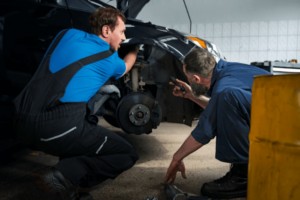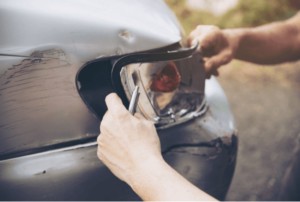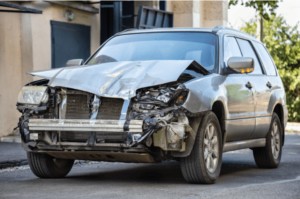Fixing a bumper can range from a simple touch-up to a full replacement, depending on the damage. At HOW.EDU.VN, we understand that navigating the world of auto repairs can be confusing, which is why we’re here to provide expert guidance and solutions to your car care questions. Whether you’re dealing with minor cosmetic issues or major structural damage, understanding the repair options and associated costs is crucial for making informed decisions to ensure your vehicle’s safety and appearance. Repair estimates vary significantly based on severity, make, and location, affecting overall auto body costs and potentially involving collision repair coverage.
1. When Is Repair the Best Option for a Bumper?
Bumper repair is often feasible when the damage is relatively minor and doesn’t affect the structural integrity of the bumper. Some common scenarios where repair is a good option include:
-
Minor Dents and Scratches: Small dents and scratches that don’t penetrate deeply into the bumper material can often be repaired using techniques like paintless dent repair (PDR) or simple filling and painting.
-
Superficial Cracks: If the cracks are small and don’t compromise the bumper’s structural integrity, they can be repaired using plastic welding techniques or epoxy fillers.
-
Cost-Effectiveness: For older vehicles, repairing the bumper can be more economical than replacing it, especially if the damage is cosmetic rather than structural.
2. When Is Replacement the Better Choice for a Bumper?
Bumper replacement is typically recommended when the damage is severe or affects the structural integrity of the bumper. Some common scenarios where replacement is necessary include:
-
Severe Damage: Deep cracks, large dents, or holes that compromise the bumper’s ability to protect the vehicle in a collision necessitate replacement.
-
Multiple Damaged Areas: If the bumper has sustained damage in multiple areas, it may be more cost-effective and safer to replace the entire bumper.
-
Damage to Mounting Points: If the mounting points that attach the bumper to the vehicle’s frame are damaged, the bumper may not be able to be securely reattached, requiring replacement.
-
Modern Safety Features: Many modern bumpers house sensors and other safety components. If these components are damaged, replacing the bumper may be necessary to ensure proper functionality.
3. Understanding the Different Types of Bumper Damage
Bumpers are susceptible to various types of damage due to their position on the car. Here’s a breakdown of common bumper damages:
- Dents: Usually caused by low-speed impacts, dents are indentations in the bumper material.
- Scratches: Ranging from surface-level marks to deeper grooves, scratches can result from brushes with other vehicles or objects.
- Cracks: More severe than scratches, cracks can compromise the structural integrity of the bumper.
- Scuffs and Scrapes: Often the result of grazing another surface, scuffs may leave paint residue or superficial damage.
- Holes and Punctures: These occur from sharp impacts and can be serious, sometimes requiring a complete bumper replacement.
- Peeling Paint: Caused by exposure to elements or poor paint jobs, leading to the paint peeling off the bumper.
4. How Much Does Car Bumper Repair Cost?
The cost to repair a car bumper can vary depending on the type and extent of the damage. On average, you can expect to pay anywhere from $150 to $600 for bumper repair. Here’s a breakdown of the costs associated with different types of damage:
| Type of Damage | Repair Needed | Average Cost |
|---|---|---|
| Minor Dent | Dent Removal | $150 – $250 |
| Scratch | Paint Touch-Up | $100 – $300 |
| Crack | Plastic Welding and Reshaping | $250 – $500 |
| Major Dent | Panel Beating and Repainting | $350 – $600 |



5. Additional Factors Influencing Bumper Repair Costs
Several factors can influence the cost of bumper repairs, including:
- Car Make and Model: Luxury or foreign cars may require specific parts or custom paint that are more expensive and harder to source.
- Labor Rates: Rates vary by location and shop type. Specialized shops or urban areas often charge more.
- Geographic Location: Costs for materials and labor can vary by region.
- Material and Part Availability: Some bumper materials, especially for newer or luxury models, can be rare and costly to obtain.
6. How Much Does Car Bumper Replacement Cost?
Sometimes, replacement is more feasible than repair. The cost for bumper replacement ranges between $500 to $1,500, varying with car types and models. Below is a table showing average prices for different cars:
| Car Type | Average Replacement Cost |
|---|---|
| Economy Car | $500 – $700 |
| Mid-Range Car | $700 – $1,000 |
| Luxury Car | $1,000 – $1,500 |
7. Factors That Affect the Bumper Replacement Cost
The cost of replacing a bumper can vary widely depending on several factors. Understanding these factors can help you estimate the potential cost and make informed decisions about your repair options. Here are the key factors that affect bumper replacement cost:
- Type of Vehicle: The make and model of your vehicle play a significant role in determining the cost of a bumper replacement. Luxury vehicles and high-end models typically have more expensive parts and may require specialized labor, leading to higher replacement costs. For example, replacing the bumper on a luxury sedan like a BMW or Mercedes-Benz could be significantly more expensive than replacing the bumper on an economy car like a Honda Civic or Toyota Corolla.
- Bumper Material: Bumpers are made from various materials, including plastic, steel, and aluminum. The material of the bumper can affect the replacement cost. Plastic bumpers are generally less expensive to replace than steel or aluminum bumpers. However, the type of plastic used can also influence the cost. For instance, some high-performance vehicles use carbon fiber bumpers, which are extremely expensive to replace.
- New vs. Aftermarket Parts: You have the option of using new original equipment manufacturer (OEM) parts or aftermarket parts for your bumper replacement. OEM parts are made by the original manufacturer of your vehicle and are typically more expensive than aftermarket parts. Aftermarket parts are made by third-party manufacturers and can be a more affordable alternative. However, the quality and fit of aftermarket parts can vary, so it’s essential to choose reputable brands and ensure the parts meet industry standards.
- Features and Technology: Modern bumpers often integrate advanced features and technology, such as parking sensors, blind-spot monitoring systems, and adaptive cruise control sensors. These features can significantly increase the cost of bumper replacement, as the sensors and related components may need to be recalibrated or replaced along with the bumper. Additionally, some bumpers may include integrated lighting, such as fog lights or daytime running lights, which can further add to the replacement cost.
- Paint and Finish: The cost of painting and finishing the new bumper to match your vehicle’s color can also impact the overall replacement cost. If your vehicle has a standard color, the painting process may be relatively straightforward and affordable. However, if your vehicle has a custom or multi-stage paint job, the painting process can be more complex and expensive. Additionally, the quality of the paint and finish can affect the cost, with premium paints and clear coats adding to the expense.
- Labor Costs: Labor costs can vary depending on the complexity of the bumper replacement and the hourly rates charged by the auto body shop. Some bumper replacements are relatively straightforward and can be completed in a few hours, while others may require more extensive work and take longer to complete. Additionally, labor rates can vary depending on the location of the auto body shop, with shops in urban areas typically charging higher rates than those in rural areas.
- Extent of Damage: The extent of the damage to your vehicle can also affect the bumper replacement cost. If the accident or collision caused damage beyond the bumper, such as damage to the vehicle’s frame or other body panels, the repair costs can increase significantly. In some cases, the vehicle may be deemed a total loss if the cost of repairs exceeds the vehicle’s value.
8. How Do You Know What Kind of Repair You Need?
Determining the right repair approach for your car bumper can be challenging. Here’s a simple checklist to help you assess the bumper damage and decide the best course of action:
- Inspect the Damage: Carefully examine the bumper for dents, scratches, cracks, or any other visible damage.
- Assess the Severity: Small dents and light scratches might only need minor repairs like paintless dent repair, while large cracks or holes may require more extensive work or even a bumper replacement.
- Check for Hidden Damage: Damage isn’t always surface level. If the bumper feels loose or there’s damage to the car’s body near the bumper, it might indicate deeper issues.
- Consider Safety and Functionality: If the damage might affect the vehicle’s safety, such as interfering with sensors or lights, professional assessment at an auto body shop is necessary.
- Professional Assessment: For complex or severe damage, or if you’re unsure, consult with a reputable repair shop. They can provide a detailed evaluation and advise on whether a simple repair or a new bumper is needed.
9. The Role of Insurance in Bumper Repairs
When dealing with bumper damage, understanding how your insurance policy applies can save you money and hassle. Here’s a breakdown of how insurance typically covers bumper repairs and what factors to consider:
- Coverage Types: Collision coverage is the primary type of insurance that covers bumper damage resulting from accidents. If you have collision coverage, your insurance company will pay for the repairs to your bumper, minus your deductible, regardless of who was at fault in the accident. Comprehensive coverage, on the other hand, typically covers bumper damage caused by non-collision events, such as vandalism, theft, or natural disasters like hail or flooding.
- Deductible: Your deductible is the amount you’re responsible for paying out of pocket before your insurance coverage kicks in. If the cost of repairing your bumper is less than or close to your deductible, it may not be worth filing a claim, as you’ll end up paying most of the cost yourself. However, if the repair costs significantly exceed your deductible, filing a claim can help you save money.
- Fault vs. No-Fault Accidents: In fault-based insurance systems, the at-fault driver’s insurance company is responsible for paying for the damages to the other driver’s vehicle. If you were at fault in the accident, your insurance company will pay for the repairs to your bumper and the other driver’s vehicle, up to your policy limits. In no-fault insurance systems, each driver’s insurance company pays for their own damages, regardless of who was at fault.
- Claim Impact on Premiums: Filing a claim for bumper damage can potentially increase your insurance premiums, especially if you were at fault in the accident or if you have a history of filing multiple claims. Insurance companies view drivers who file frequent claims as higher risk and may increase their premiums to offset the perceived risk. However, some insurance companies offer accident forgiveness programs that prevent your premiums from increasing after your first at-fault accident.
- Policy Limits: Your insurance policy has limits on the amount it will pay for damages. It’s essential to understand your policy limits and ensure they’re sufficient to cover potential repair costs. If the cost of repairing your bumper exceeds your policy limits, you’ll be responsible for paying the difference out of pocket.
- Estimates and Approval: Before starting any repairs, it’s crucial to get an estimate from a reputable auto body shop and submit it to your insurance company for approval. The insurance company may send an adjuster to inspect the damage and verify the estimate. It’s essential to work with a shop that has experience working with insurance companies and can negotiate on your behalf to ensure you receive a fair settlement.
10. How to Save Money on Bumper Repairs
Bumper repairs can be costly, but there are several ways to save money without compromising the quality of the work. Here are some tips:
- Get Multiple Estimates: Obtain estimates from several different auto body shops before making a decision. This will give you a better understanding of the average cost for the repair and allow you to compare prices and services.
- Consider Aftermarket Parts: Aftermarket parts are generally less expensive than OEM parts. However, ensure that the aftermarket parts are of good quality and meet industry standards.
- DIY Repairs: If the damage is minor, you may be able to repair it yourself using DIY kits or products. However, be cautious when attempting DIY repairs, as improper techniques can worsen the damage and increase the overall cost of repairs.
- Negotiate with the Shop: Don’t be afraid to negotiate with the auto body shop on the price of the repair. Some shops may be willing to offer discounts or match prices from competitors.
- Check for Coupons and Promotions: Look for coupons and promotions offered by auto body shops. Many shops offer discounts on specific services or repairs.
- Maintain Your Bumper: Regular maintenance, such as washing and waxing your bumper, can help prevent damage and extend its lifespan.
11. Factors to Consider When Choosing a Repair Shop
Choosing the right repair shop is crucial to ensuring a quality repair and a positive experience. Here are some factors to consider when selecting a repair shop:
- Reputation and Reviews: Check online reviews and ask for recommendations from friends and family. A reputable shop will have positive reviews and a track record of providing excellent service.
- Certifications and Accreditation: Look for shops that are certified by industry organizations such as I-CAR or ASE. These certifications indicate that the shop meets certain standards for quality and expertise.
- Experience and Expertise: Choose a shop that has experience working on your make and model of vehicle. A shop with specialized expertise in bumper repairs will be able to provide a more accurate assessment and a higher quality repair.
- Warranty: Ask about the shop’s warranty policy. A reputable shop will offer a warranty on their work, giving you peace of mind that the repair will be done correctly.
- Customer Service: Pay attention to the level of customer service you receive from the shop. A good shop will be responsive to your questions and concerns and will keep you informed throughout the repair process.
12. The Environmental Impact of Bumper Repairs
Bumper repairs and replacements can have environmental impacts, particularly in terms of waste generation and the use of resources. Here are some considerations regarding the environmental impact of bumper repairs:
- Recycling: Many bumper materials, such as plastic and metal, can be recycled. Choosing to repair rather than replace a bumper can help reduce waste and conserve resources.
- Paint and Solvents: The painting process involved in bumper repairs can generate air pollution and hazardous waste. Look for shops that use environmentally friendly paints and solvents and follow proper disposal procedures for hazardous waste.
- Energy Consumption: The repair process can consume energy, particularly for activities such as welding, grinding, and painting. Choosing a shop that uses energy-efficient equipment and practices can help reduce the environmental impact.
- Transportation: Transporting damaged bumpers and replacement parts can contribute to greenhouse gas emissions. Choosing a local shop can help reduce transportation-related emissions.
13. The Future of Bumper Technology
Bumper technology is constantly evolving, with new materials, designs, and features being developed to improve safety, performance, and aesthetics. Here are some trends and developments in bumper technology:
- Advanced Materials: Manufacturers are increasingly using advanced materials such as carbon fiber, fiberglass, and high-strength plastics to create bumpers that are lighter, stronger, and more impact-resistant.
- Smart Bumpers: Some vehicles are equipped with smart bumpers that incorporate sensors and other technology to detect and mitigate collisions. These bumpers can automatically deploy airbags or activate braking systems to reduce the severity of accidents.
- Aerodynamic Designs: Bumpers are being designed with aerodynamics in mind to improve fuel efficiency and reduce wind resistance.
- Customization Options: Many manufacturers offer customization options for bumpers, allowing drivers to personalize the appearance of their vehicles.
14. Insurance and Your Bumper: Balancing Costs and Coverage
When considering whether to file an insurance claim for bumper repair or replacement, it’s crucial to understand the potential impact on your insurance premiums. Here are key points to consider:
- Cost of Repair vs. Deductible: Compare the bumper repair cost to your deductible. If the repair cost for your damaged bumper is close to or less than your deductible, paying out of pocket might be more cost-effective.
- Nature of the Accident: If you were at fault, filing a claim could lead to an increase in your car insurance premiums. However, for no-fault accidents, especially if the other party’s insurance is covering the costs, your premiums should not be affected.
- Frequency of Claims: Filing multiple claims, even for minor damage, can lead to higher premiums. Your insurance company will consider your claim history.
- Policy Terms: Understand your insurance coverage, including aspects like collision repair coverage and whether you have accident forgiveness, which can influence your decision.
- Long-Term Cost Consideration: Weigh the long-term cost of increased premiums against the immediate bumper replacement cost or repair expenses.
- Claim History and Loyalty: A long, claim-free history with your insurance company might influence their decision on premium adjustments.
15. Frequently Asked Questions (FAQs) About Bumper Repair
-
Can a cracked bumper be repaired, or does it always need to be replaced?
Answer: It depends on the severity and location of the crack. Minor cracks can often be repaired using plastic welding or epoxy fillers, while more severe cracks may require bumper replacement.*
-
Is it cheaper to repair or replace a bumper?
Answer: Generally, repairing a bumper is cheaper than replacing it. However, if the damage is extensive, replacement may be the more cost-effective option.*
-
Will repairing a bumper affect the safety of my car?
Answer: If the repair is done properly by a qualified technician, it should not affect the safety of your car. However, if the damage is severe or the repair is not done correctly, it could compromise the bumper’s ability to protect the vehicle in a collision.*
-
How long does it take to repair a bumper?
Answer: The time it takes to repair a bumper can vary depending on the extent of the damage and the repair techniques used. Minor repairs may only take a few hours, while more extensive repairs could take a day or two.*
-
Can I repair a bumper myself?
Answer: It is possible to repair a bumper yourself using DIY kits or products. However, it is important to be cautious when attempting DIY repairs, as improper techniques can worsen the damage and increase the overall cost of repairs. If you are not comfortable with DIY repairs, it is best to take your car to a qualified technician.*
-
Will my insurance cover bumper repair?
Answer: Whether your insurance will cover bumper repair depends on your policy coverage and the circumstances of the damage. If you have collision coverage, your insurance company will typically pay for the repairs to your bumper, minus your deductible. However, if you were at fault in the accident, your premiums may increase.*
-
What is paintless dent repair (PDR)?
Answer: Paintless dent repair (PDR) is a technique used to remove minor dents and dings from vehicle panels without affecting the paint finish. This technique involves using specialized tools to gently massage the metal back into its original shape.*
-
Can parking sensors be reinstalled after a bumper repair?
Answer: Yes, parking sensors can typically be reinstalled after a bumper repair. However, it is important to ensure that the sensors are properly calibrated and functioning correctly after the repair.*
-
What is the difference between OEM and aftermarket bumpers?
Answer: OEM (Original Equipment Manufacturer) bumpers are made by the original manufacturer of your vehicle, while aftermarket bumpers are made by third-party manufacturers. OEM bumpers are typically more expensive than aftermarket bumpers, but they are guaranteed to fit and perform properly.*
-
How can I find a reputable auto body shop for bumper repair?
Answer: You can find a reputable auto body shop by checking online reviews, asking for recommendations from friends and family, and looking for shops that are certified by industry organizations such as I-CAR or ASE.*
Dealing with bumper damage requires careful attention and expertise. Choosing the right professionals ensures your repair process is smooth and stress-free.
At HOW.EDU.VN, we connect you with over 100 renowned PhDs ready to provide expert advice tailored to your specific situation. Don’t let bumper damage stress you out. Contact us today at 456 Expertise Plaza, Consult City, CA 90210, United States, or WhatsApp at +1 (310) 555-1212, or visit our website how.edu.vn to get started.
